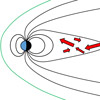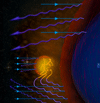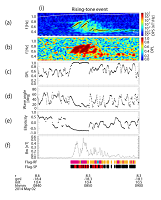
2016 THEMIS SCIENCE NUGGETS
SUMMARIES OF THEMIS RESEARCH
| <<View 2015 THEMIS Nuggets | Return to main page |
 Mitsuo Oka, February 2016
Mitsuo Oka, February 2016In situ evidence of electron energization in the electron diffusion region of magnetotail reconnection
THEMIS fortuitously encountered an electron diffusion region in the magnetotail and found significant electron energization there. Read more.
 Dennis Frühauff, April 2016
Dennis Frühauff, April 2016Statistical analysis of magnetotail fast flows and related magnetic disturbances
The long-term availability of THEMIS data in the magnetotail makes it worth statistically revisiting the characteristics of fast flows in the Earth’s surroundings. The different orbits of the five spacecraft enable the comparison of distributions near Earth (~10 Re downtail) and far down the magnetotail (~60 Re). Read more.
 Andrew P. Dimmock, April 2016
Andrew P. Dimmock, April 2016The dawn-dusk asymmetry of ion density in the dayside magnetosheath and its annual variability measured by THEMIS
A statistical study of the dawn-dusk asymmetry of ion number density close to the dayside magnetopause measured by the THEMIS spacecraft. The statistical observations suggest that the asymmetry varies with the solar cycle; in these data, the asymmetry peaked during 2009 close to the solar minimum. Read more.
 Suping Duan, April 2016
Suping Duan, April 2016Evidence of kinetic Alfvén eigenmode in the near-Earth magnetotail during substorm expansion phase
We present detailed THEMIS observations of unipolar pulses that are identified as a kinetic Alfvén wave eigenmode in the near-Earth (10-11RE) magnetotail during substorm expansion phase. Read more.
 Aki Ieda, April 2016
Aki Ieda, April 2016Stepwise tailward retreat of magnetic reconnection: THEMIS observations of an auroral substorm
Auroral breakups are often repeated with new breakups in higher latitudes. We have tried to explain these tendencies with auroral images and satellite observations of Earth's tail. Read more.
 Terry Liu, May 2016
Terry Liu, May 2016Observations of a new foreshock region upstream of a foreshock bubble's shock
We present the first definite observation of a new ion and electron foreshock upstream of a shockwave that formed due to the expansion of a population of energized plasma (a foreshock bubble), which is found upstream of Earth's bow shock. THEMIS satellites showed that the foreshock bubble's shock can reflect and accelerate solar wind particles providing an additional accelerator and also a particle source for the parent bow shock acceleration. These findings can shed light on fundamental shock acceleration processes throughout our universe. Read more.
 San Lu, July 2016
San Lu, July 2016On the current density reduction ahead of dipolarization fronts
Dipolarization fronts (DFs) are typically described as thin current sheets moving towards the Earth, which play a crucial role in the earthward transport of energy and magnetic flux. DFs can interact with ambient ions by reflecting and accelerating them. At the same time, the interaction also affects the DFs' movements by creating a local pressure/density enhancement. Read more.
 Evgeny Panov, July 2016
Evgeny Panov, July 2016On the current density reduction ahead of dipolarization fronts
Dipolarization fronts (DFs) are typically described as thin current sheets moving towards the Earth, which play a crucial role in the earthward transport of energy and magnetic flux. DFs can interact with ambient ions by reflecting and accelerating them. At the same time, the interaction also affects the DFs' movements by creating a local pressure/density enhancement. Read more.
 Toshi Nishimura, August 2016
Toshi Nishimura, August 2016Statistical properties of substorm auroral onset beads/rays
Auroral substorms are often associated with optical ray or bead structures during initial brightening. In this study we investigate the properties of these substorm auroral onset waves. Read more.
 Kazue Takahashi, August 2016
Kazue Takahashi, August 2016Propagation of upstream ULF waves to the midnight region of the magnetosphere
Previous research of magnetospheric Pc3 waves have been limited to the day side. In this recent study we show that the waves can propagate over long distances to the night side. Read more.
 Satoko Nakamura, September 2016
Satoko Nakamura, September 2016A statistical study of EMIC rising and falling tone emissions observed by THEMIS
The paper shows that the occurrence rate of EMIC rising- or falling tone events is more than 30% of the total EMIC wave events. The dayside magnetosphere is a preferential region for the EMIC frequency variations. Read more.
 Lynn B. Wilson III, November 2016
Lynn B. Wilson III, November 2016Relativistic electrons produced by foreshock disturbances observed upstream of the Earth's bow shock
THEMIS discovers electrons energized from thermal to relativistic energies by electromagnetic waves and structures upstream of the Earth's bow shock in the ion foreshock. These results were completely unexpected and cannot be explained by any of the current shock acceleration models. Read more.
 Please send comments/suggestions to
Emmanuel Masongsong / emasongsong @ igpp.ucla.edu
Please send comments/suggestions to
Emmanuel Masongsong / emasongsong @ igpp.ucla.edu